The Groundwater Resources in the Mazovian Lowland in Central Poland during the Dry Decade of 2011–2020
Abstract
1. Introduction
2. Materials and Methods
2.1. Study Area and Data
2.2. Land Use
2.3. Hydrogeological and Hydrometeorlogical Characteristic
2.4. Water Withdrawals for Municipal Economy, Industry and Agriculture
2.5. Hydrogeological Groundwater Droughts
2.6. Hydrological Streamflow Drought
3. Results and Discussion
3.1. Groundwater Levels in the Period 2010–2022 in Poland
3.2. Meteorological Conditions during the Period 2011–2020 (the Drought Decade) in Poland and the Zagożdżona Watershed
3.3. Variability of Groundwater and Surface Water Levels in the Period 2011–2020
3.3.1. Seasonal Variability of Groundwater Levels Based on Daily Levels in Dry Years
3.3.2. Monthly and Annual Variability of Groundwater Levels Based on Mean and Extreme Values in the Period 2011–2020
3.3.3. Direction of Changes in the Period 2011–2020
3.4. Hydrological Streamflow Drought and Hydrogeological Groundwater Drought
4. Summary and Conclusions
Author Contributions
Funding
Data Availability Statement
Conflicts of Interest
References
- Hejduk, L.; Kaznowska, E.; Wasilewicz, M.; Hejduk, A. Dynamics of the Natural Afforestation Process of a Small Lowland Catchment and Its Possible Impact on Runoff Changes. Sustainability 2021, 13, 10339. [Google Scholar] [CrossRef]
- Academia. Komunikat 01/2020 Interdyscyplinarnego Zespołu Doradczego Do Spraw Kryzysu Klimatycznego Przy Prezesie PAN Na Temat Zmiany Klimatu i Gospodarki Wodnej w Polsce. ACADEMIA Mag. Pol. Akad. Nauk. 2020, 100–105. [Google Scholar]
- Dobrowolski, A.; Słota, H. Stan Zasobów Wodnych Polski w Drugiej Połowie XX w. Postępy Nauk. Rol. 2005, 52, 21–31. [Google Scholar]
- Biuletyn IMGW. Biuletyn Państwowej Służby Hydrologiczno-Meteorologicznej; Instytut Meteorologii i Gospodarki Wodnej Państwowy Instytut Badawczy: Warszawa, Poland, 2022. [Google Scholar]
- Tokarczyk, T.; Szalińska, W.; Otop, I.; Bedryj, M. Zarządzenie Ryzykiem Suszy; Moografie Komitetu Gospodarki Wodnej Polskiej Akademii Nauk: Warszawa, Poland, 2017. [Google Scholar]
- Górski, T. Changes in Poland’s Agroclimatic Conditions over the Last Century. Pap. Glob. Chang. IGBP 2007, 14, 55–67. [Google Scholar]
- Babś, D.; Marcinowicz, R. Meteorologiczne Uwarunkowania Powodzi Błyskawicznych w Gdańsku w 2018 Roku. In Współczesne problemy klimatu Polski; Instytut Meteorologii i Gospodarki Wodnej Państwowy Instytut Badawczy: Warszawa, Poland, 2019; pp. 161–171. [Google Scholar]
- Karaczun, Z. Sytuacja Małych Gospodarstw w Europie Wygląda źle. (The Situation of Small Farms Looks Bad in Europe). The Cap and Small Farms. Action Co-Financed by the European Commission. Available online: https://www.euractiv.pl/section/rolnictwowpr/video/prof-karaczun-sytuacja-malych-gospodarstw-w-europie-wyglada-zle/#ea-comments (accessed on 3 February 2020).
- Kowalczyk, A. Zjawisko Suszy w Wodach Podziemnych i Sposoby Łagodzenia Jego Negatywnych Skutków. Water Manag. 2022, 1, 21–27. [Google Scholar] [CrossRef]
- Kępińska-Kasprzyk, M. Zagrożenia Dla Rolnictwa. Obserwator IMGW. Wydanie specjalne. Susza zmienia wszystko. 2020, 11–13. [Google Scholar]
- Wawer, R. Gospodarowanie Wodą w Rolnictwie w Zmieniającym Się Klimacie Perspektywa Przejścia Na Rolnictwo Nawadniane a Sprawiedliwe i Zrównoważone Korzystanie z Wód w Świetle Rozwiązań Hiszpańskich i Postępu w Informatyce. Pol. J. Agron. 2020, 41, 38–48. [Google Scholar] [CrossRef]
- Najwyższa Izba Kontroli (NIK). NIK Informacja o Wynikach Kontroli Przeciwdziałanie Niedoborom Wody w Rolnictwie. KRR.430.006.2020 Nr Ewid. 192/2020/P/20/043/KRR. Departament Rolnictwa i Rozwwoju Wsi. 2020. Available online: https://www.imgw.pl/sites/default/files/2021-01/imgw-obserwator-susza-2020.pdf (accessed on 3 February 2020).
- Łabędzki, L.; Kanecka-Geszke, E. Deficyty Wody i Potrzeby Nawodnień roślin Uprawnych w Polsce. In Nnowacyjne Metody Gospodarowania Zasobami Wodnymi w Rolnictwie; Centrum Doradztwa Rolniczego w Brwinowie: Brwinów, Poland, 2016; pp. 241–259. [Google Scholar]
- Wawer, R.; Niedźwiecki, J.; Łysoń, P.; Dembek, W.; Treder, W.; Kanecka-Geszke, E. Adaptacja Gospodarki Wodnej w Rolnictwie Do Zmieniającego Się Klimatu; IUNG-PIB: Puławy, Poland, 2020; ISBN 978-83-7562-332-1. [Google Scholar]
- Herbich, P. Optymalizacja Poboru Wód Podziemnych Do Nawadniania Użytków Rolnych w Okresie Suszy. In Wybrane Zagadnienia Hydrogeologiczne oraz Różne Aspekty Związane z Eksploatacją wód Podziemnych; Krogulec, E., Ed.; Wydawnictwo Uniwersytetu Łódzkiego: Łódź, Poland, 2021; ISBN 978-83-8220-655-5. [Google Scholar]
- Herbich, P. Ocena Możliwości Wykorzystania Rezerw Zasobów Dyspozycyjnych Wód Podziemnych Do Łagodzenia Skutków Suszy w Rolnictwie. Biuletyn PIG 2019, 475, 51–58. [Google Scholar] [CrossRef]
- UN Water (Ed.) Groundwater Making the Invisible Visible; The United Nations world water development report; UNESCO: Paris, France, 2022; ISBN 978-92-3-100507-7. [Google Scholar]
- OECD. Drying Wells, Rising Stakes: Towards Sustainable Agricultural Groundwater Use; OECD Studies on Water; OECD: Paris, France, 2015; ISBN 978-92-64-23869-5. [Google Scholar]
- Taylor, R.G.; Scanlon, B.; Döll, P.; Rodell, M.; Van Beek, R.; Wada, Y.; Longuevergne, L.; Leblanc, M.; Famiglietti, J.S.; Edmunds, M.; et al. Ground Water and Climate Change. Nature Clim Chang. 2013, 3, 322–329. [Google Scholar] [CrossRef]
- Hertel, T.W.; Liu, J. Implications of Water Scarcity for Economic Growth. In Economy-Wide Modeling of Water at Regional and Global Scales; Springer: Singapore, 2019. [Google Scholar] [CrossRef]
- Wawer, R. Uwagi o Użytkowaniu Zasobów Wód Podziemnych Na Przykładzie Hiszpanii. Ekspertyza. Woda w rolnictwie 2020, 68–71. [Google Scholar]
- Marszelewski, W. XXI Wiek Będzie Wiekiem Wody. Co to Oznacza? Polityka 7 February 2021.
- Piniewski, M.; Marcinkowski, P.; Okruszko, T. Modelowanie Hydrologiczne Jako Narzędzie Do Oceny Skuteczności Działań Zwiększających Dostępność Zasobów Wodnych; Szkoła Hydrologii: Legionowo, Poland, 2023. [Google Scholar]
- Banasik, K.; Hejduk, L. Flow Duration Curves for Two Small Catchments with Various Records in Lowland Part of Poland. Annu. Set Environ. Prot. 2013, 15, 287–300. [Google Scholar]
- Wiencław, E.; Złotoszewska-Niedziałek, H. Zasobność Wód Podziemnych. In Metodyka Zagospodarowania Zasobów Wodnych w Małych Zlewniach Rzecznych; Ciepielowski, A., Ed.; Wydawnictwo SGGW: Warszawa, Poland, 1995; pp. 106–111. [Google Scholar]
- Wiencław, E.; Złotoszewska-Niedziałek, H.; Ciepielowski, A. Warunki Hydrogeologiczne Zlewni Rzeki Zagożdżonki. Przegląd Nauk. Wydziału Melior. I Inżynierii Sr. 1993, 2, 25–38. [Google Scholar]
- Kaznowska, E.; Hejduk, L.; Hejduk, A. Charakterystyka Występowania Wezbrań i Niżówek w Małej Zlewni Niziny Mazowieckiej. Woda-Sr.-Obsz. Wiej. 2015, 15, 45–59. [Google Scholar]
- Kaznowska, E.; Banasik, K.; Hejduk, A.; Krajewski, A.; Wasilewicz, M.; Hejduk, L.; Gładecki, J. Charakterystyki Hydrologiczne Małej Zlewni Południowego Mazowsza Od Połowy XX Wieku (Hydrological Characteristic since the Mid-Twentieth Century of Small Catchment in Southern Mazovian Region, Poland). In Współczesne problemy klimatu Polski; Chojnacka-Ożga, L., Lorenc, H., Eds.; Wydawnictwo IMGW-PIB: Warsaw, Poland, 2019; pp. 135–146. [Google Scholar]
- Ślusarek, W.; Gągol, J.; Kwecko, P.; Tomassi-Morawiec, H.; Wojciechowska, K.; Hrybowicz, G. Objaśnienia Do Mapy Geośrodowiskowej Polski 1:50,000; Arkusz Pionki (708) 2010; Panstwowy Instytut Geologiczny: Warsaw, Poland, 2010; p. 42.
- Uchwała Gminy Przytyk Program Ochrony Środowiska Dla Gminy Przytyk Na Lata 2017–2020 z Perspektywą Do 2024 Roku 2017. Available online: https://bip.przytyk.pl/upload/dad93Uchwala_XXXVII_271_2017.pdf (accessed on 28 December 2023).
- Wojciechowski, A. Program Ochrony Środowiska Powiatu Radomskiego 2003. Available online: https://www.spradom.finn.pl/res/serwisy/bip-spradom/komunikaty/_005_003_53257.pdf?version=1.0 (accessed on 28 December 2023).
- Raport o Stanie Gminy Pionki, za Rok 2022. May 2023; p. 100. Available online: https://bip.gmina-pionki.pl/strona-4103-raport_o_stanie_gminy_pionki_rok_2022_r.html (accessed on 28 December 2023).
- Wiencław, E.; Złotoszewska-Niedziałek, H.; Ciepielowski, A. Warunki Występowania i Eksploatacji Wód Podziemnych w Rejonie Zlewni Badawczej Rzeki Zagożdżonki. Przegląd Nauk. Wydziału Melior. I Inżynierii Sr. 1995, 7, 55–61. [Google Scholar]
- GUS Główny Urząd Statystyczny. Ochrona Środowiska. Rok 2020; GUS Główny Urząd Statystyczny: Warsaw, Poland, 2020.
- GUS Główny Urząd Statystyczny. Ochrona Środowiska. Rok 2010; GUS Główny Urząd Statystyczny: Warsaw, Poland, 2010.
- GUS Główny Urząd Statystyczny. Ochrona Środowiska. Rok 2022; GUS Główny Urząd Statystyczny: Warsaw, Poland, 2022.
- Ciepielowski, A.; Jurczuk, S.; Wiencław, E. Charakterystyka Przyrodniczo-Geograficzna i Gospodarcza. In Metodyka Zagospodarowania Zasobów Wodnych w Małych Zlewniach Rzecznych; Ciepielowski, A., Ed.; Wydawnictwo SGGW: Warszawa, Poland, 1995; pp. 79–84. [Google Scholar]
- Jurczuk, S.; Ciepielowski, A.; Mordziński, S. Określenie Potrzeb Wodnych. In Metodyka Zagospodarowania Zasobów Wodnych w Małych Zlewniach Rzecznych; Wydawnictwo SGGW: Warszawa, Poland, 1995; pp. 115–121. [Google Scholar]
- Kowalczyk, A. Występowanie Niżówki Hydrogeologicznej w Polsce; Wywiad z Ekspertką PIG–PIB 3 June 2022; Państwowy Instytut Geologiczny-Państwowy Instytut Badawczy: Warsaw, Poland, 2022.
- Kowalczyk, A.; Szydło, M.; Stępińska-Drygała, I.; Wesołowski, P.; Bejger, M.; Gołębiewski, M. (Eds.) Niżówki Hydrogeologiczne w Polsce w Latach 1981–2015 in Informator PSH; Państwowy Instytut Geologiczny-Państwowy Instytut Badawczy: Warszawa, Poland, 2017; p. 120. ISBN 978-83-7863-722-6.
- Farat, R.; Kępińska-Kasprzak, M.; Kowalczyk, P.; Mager, P. Susze Na Obszarze Polski w Latach 1951–1990 [Droughts in Poland in the Years 1951–1990]; Materiały Badawcze IMGW. Gospodarka Wodna i Ochrona Wód; IMGW: Warszawa, Poland, 1995. [Google Scholar]
- Strzebońska-Ratomska, B. Metodyka Oceny Intensywności i Zasięgu Suszy Hydrologicznej, Cz. I, Susza Hydrologiczna Na Podkarpaciu w Latach 1961–1990. Wiadomości IMGW 1994, XVII, 15–42. [Google Scholar]
- Tomalski, P. Ekstremalne Stany Wód Podziemnych w Środkowej Polsce w Wieloleciu 1951–2000. Acta Univ. Lodziensis. Folia Geogr. Phys. 2000, 8, 131–150. [Google Scholar]
- Krogulec, E.; Sawicka, K.; Zabłocki, S. Groundwater Vulnerability in Hydrogeological Drought Conditions in Shallow Aquifers. Biul. PIG 2019, 475, 101–108. [Google Scholar] [CrossRef]
- Kaznowska, E.; Banasik, K. Streamflow Droughts and Probability of Their Occurrence in a Small Agricultural Catchment. Ann. Wars. Univ. Life Sci.-SGGW Land Reclam. 2011, 43, 57–69. [Google Scholar] [CrossRef]
- Kaznowska, E. Analysis of low flow characteristics and drought frequency in agricultural catchments. In Prediction and Reduction of Diffuse Pollution, Solid Emission and Extreme Flows from Rural Areas–Case Study of Small Agricultural Catchment; Banasik, K., Øygarden, L., Hejduk, L., Eds.; Wydawnictwo SGGW: Warszawa, Poland, 2011; pp. 27–46. [Google Scholar]
- Kaznowska, E.; Banasik, K. Ocena Intensywności Niżówek Rzecznych w Malej Zlewni Rolniczej Niziny Mazowieckiej w Ostatnich 45 -Latach (Intensity of Streamflow Droughts in Small Agricultural Catchment of Mazowiecka Lowland in Last 45 Years). Acta Sci. Form. Circumiectus 2009, 8, 5–16. [Google Scholar]
- Jakubowski, W.; Radczuk, L. Nizowka2003 Software. In Hydrological Drought—Processes and Estimation Methods for Streamflow and Groundwater; Tallaksen, L.M., van Lanen, H.A.J., Eds.; Developments in Water Science; Elsevier: Amsterdam, The Netherlands, 2004. [Google Scholar]
- Kowalczyk, A. Między Suszą a Powodzią–Analiza Ekstremalnych Stanów Wód Podziemnych. In Proceedings of the Presented at the 3Forum PSH, Warszawa, Poland, 8 March 2022. [Google Scholar]
- PIG. Rocznik Hydrogeologiczny Państwowej Służby Hydrogeologicznej; Rok Hydrologiczny 2022; Państwowy Instytut Geologiczny: Warszawa, Poland, 2023.
- Hejduk, A.; Kaznowska, E.; Hejduk, L.; Gładecki, J. Reżim opadów i przepływów w zlewni rzeki Zagożdżonki po profile Płachty Stare i Czarna. Woda-Sr.-Obsz. Wiej. 2018, 18, 37–55. [Google Scholar]
- Łabędzki, L. Susze Rolnicze. Zarys Problematyki Oraz Metodyki Monitorowania i Klasyfikacji. Woda-Sr.-Obsz. Wiej. Rozpr. Nauk. I Monogr. 2006, 17, 1–107. [Google Scholar]
- Somorowska, U. Amplified Signals of Soil Moisture and Evaporative Stresses across Poland in the Twenty-First Century. Sci. Total Environ. 2022, 812, 151465. [Google Scholar] [CrossRef] [PubMed]
- Popkiewicz, M.; Bułgajewski, H. 10 Klimatycznych i Pogodowych Zdarzeń Rekordowego 2020 Roku. Available online: https://naukaoklimacie.pl/aktualnosci/10-klimatycznych-i-pogodowych-zdarzen-rekordowego-2020-roku-452/ (accessed on 21 January 2021).
- IMGW-PIB Klimat Polski 2020. 2021. Available online: https://www.imgw.pl/sites/default/files/2021-04/imgw-pib-klimat-polski-2020-opracowanie-final-rozkladowki-min.pdf1 (accessed on 25 April 2022).
- Wojajczyk, J. Susza w Polsce Trwa Od Lat. Skutki Będą Opłakane. Available online: https://zielona.interia.pl/klimat/news-susza-w-polsce-trwa-od-lat-skutki-beda-oplakane,nId,6951206 (accessed on 11 August 2023).
- Szklarek, S. Ograniczenia w Korzystaniu z Wody Wodociągowej 2019. Świat Wody. 2019. Available online: https://swiatwody.blog/2019/06/18/apele-o-ograniczenie-korzystania-z-wody-wodociagowej-2019/ (accessed on 18 June 2019).
- Kaznowska, E.; Wasilewicz, M. Historical streamflow droughts on the Vistula River in Warsaw in the context of the current ones. Acta Sci. Pol. Form. Circumiectus 2020, 19, 53–81. [Google Scholar]
- Dziugieł, D. Susza Trawi Polskę. Tak Wygląda Katastrofa Klimatyczna. Available online: https://tvn24.pl/premium/susza-trawi-polske-tak-wyglada-katastrofa-klimatyczna-4581294 (accessed on 15 May 2020).
- Rutkowski, A.; Wiatr, A.; Wróblewski, W. Ochrona Przeciwpożarowa. Available online: https://www.biebrza.org.pl/1268,ochrona-przeciwpozarowa (accessed on 19 November 2021).
- PIG. Rocznik Hydrogeologiczny Państwowej Służby Hydrogeologicznej; Rok Hydrologiczny 2009; Państwowy Instytut Geologiczny: Warszawa, Poland, 2010.
- IMGW-PIB. Biuletyn Państwowej Służby Hydrologiczno-Meteorologicznej. Październik 2020; Instytut Meteorologii i Gospodarki Wodnej Państwowy Instytut Badawczy: Warsaw, Poland, 2020; Volume 10. [Google Scholar]
- Banasik, K.; Hejduk, L.; Hejduk, A.; Kaznowska, E.; Banasik, J.; Byczkowski, A. Wieloletnia zmienność odpływu z małej zlewni rzecznej w regionie Puszczy Kozienickiej. Sylwan 2013, 157, 578–586. [Google Scholar]
- Rutkowska, A.; Osuch, M.; Żelazny, M.; Banasik, K.; Klimek, M. Climatic and anthropogenic drivers of zero-flow events in intermittent rivers in Poland. J. Water Land Dev. 2023, 57, 52–61. [Google Scholar] [CrossRef]
- Somorowska, U. Wpływ Stanu Retencji Podziemnej Na Proces Odpływu w Zlewni Nizinnej; Wydawnictwo Uniwersytetu Warszawskiego: Warszawa, Poland, 2006; ISBN 978-83-235-2858-6. [Google Scholar]
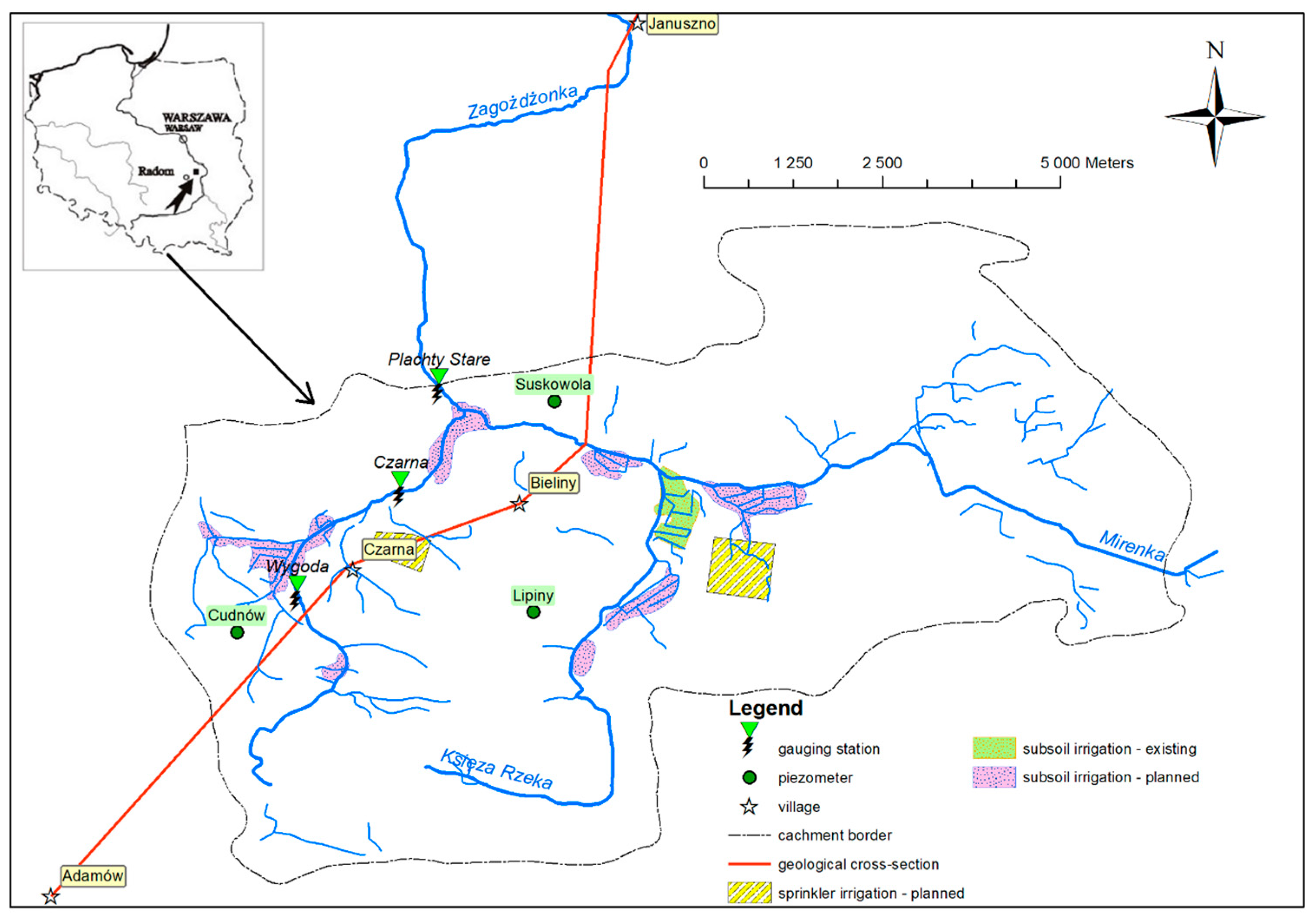

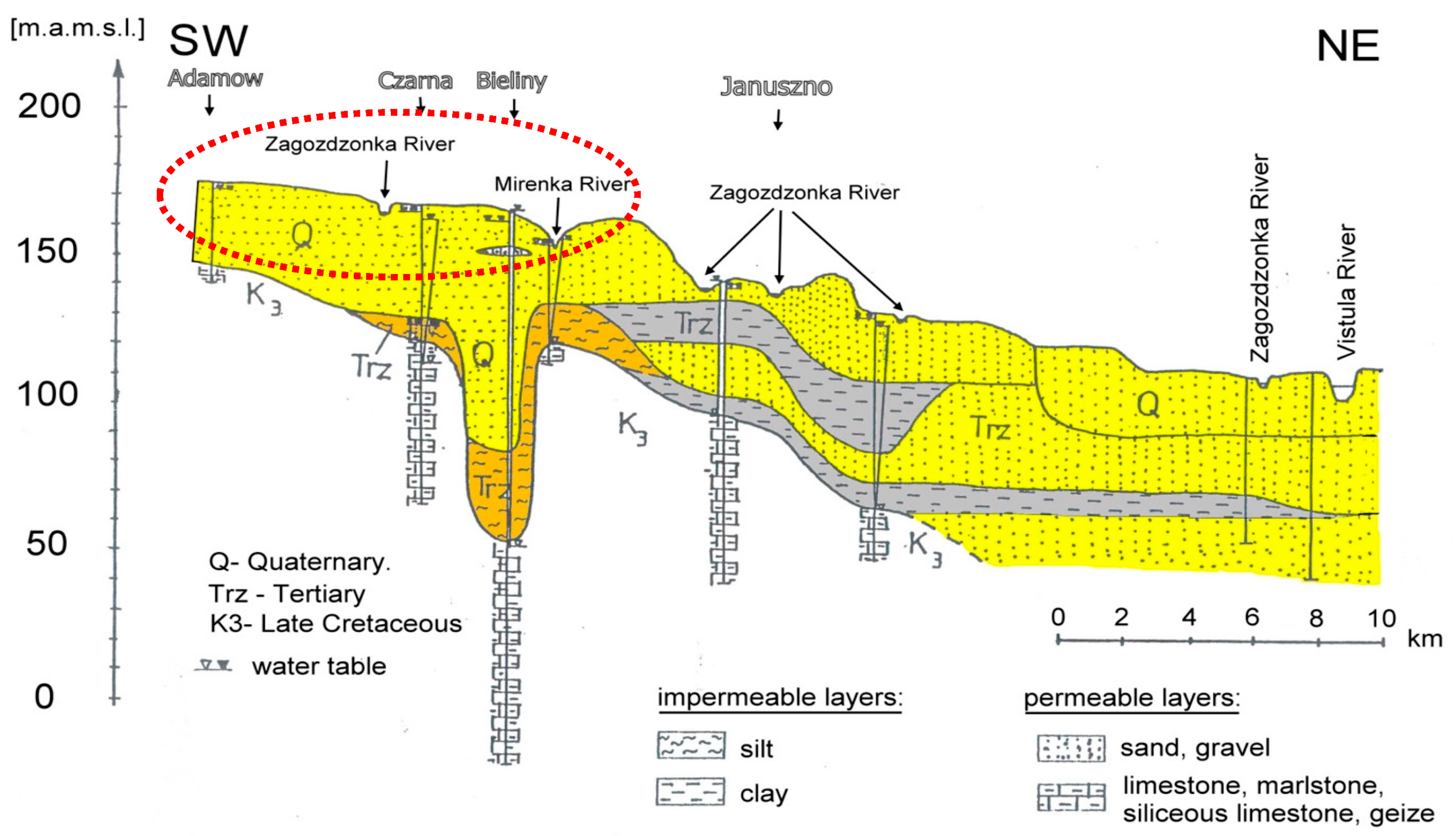
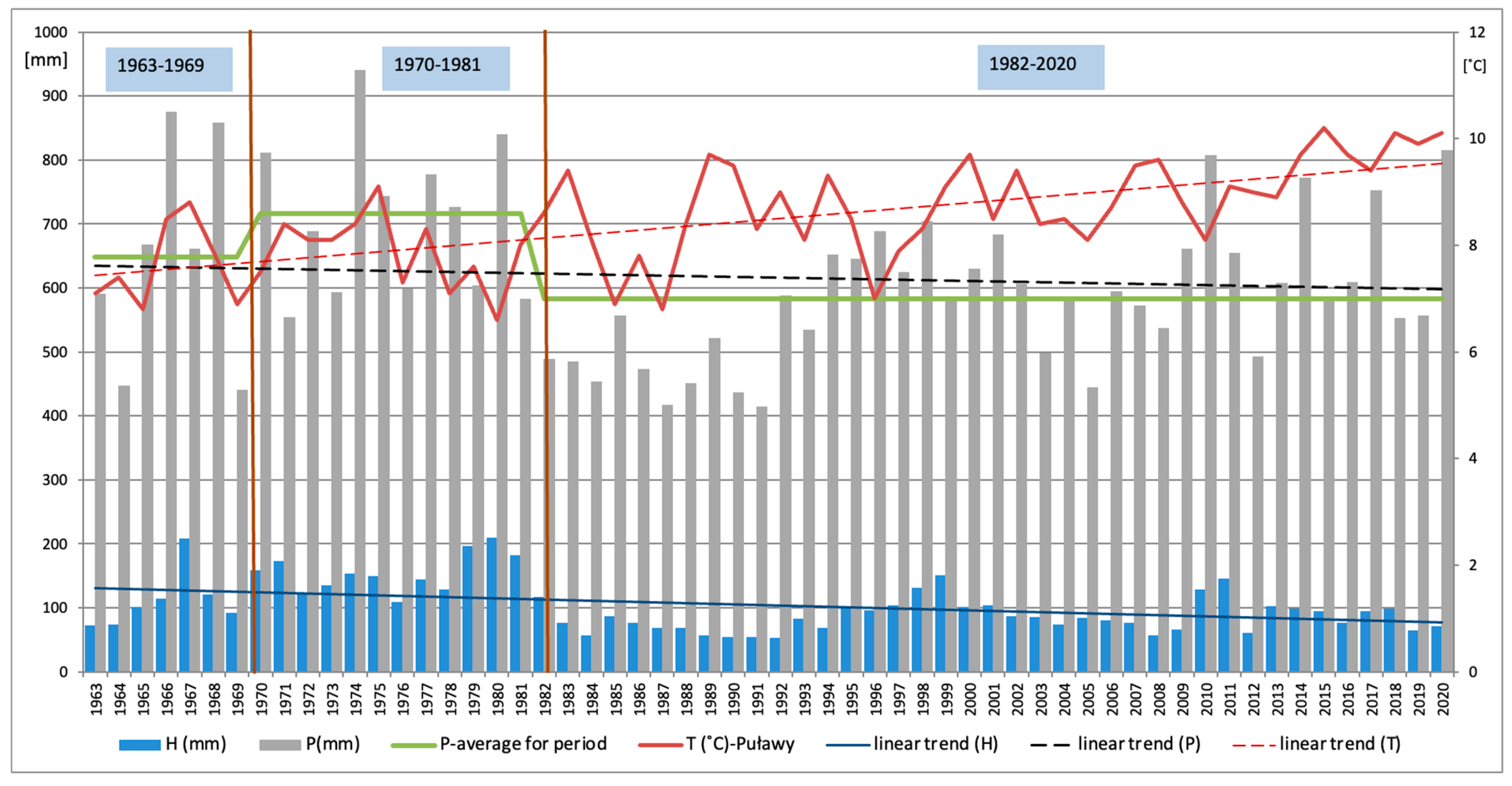



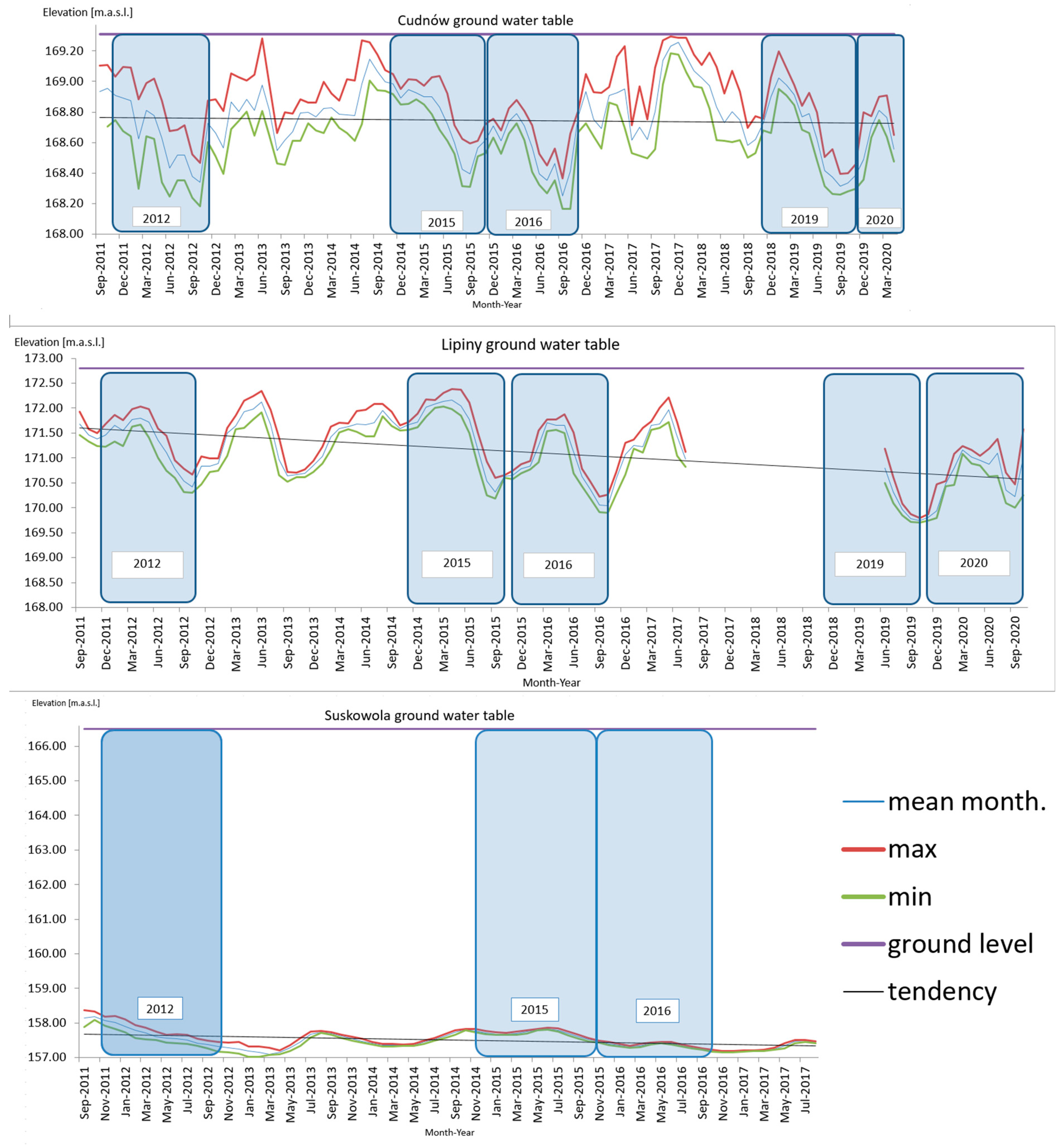
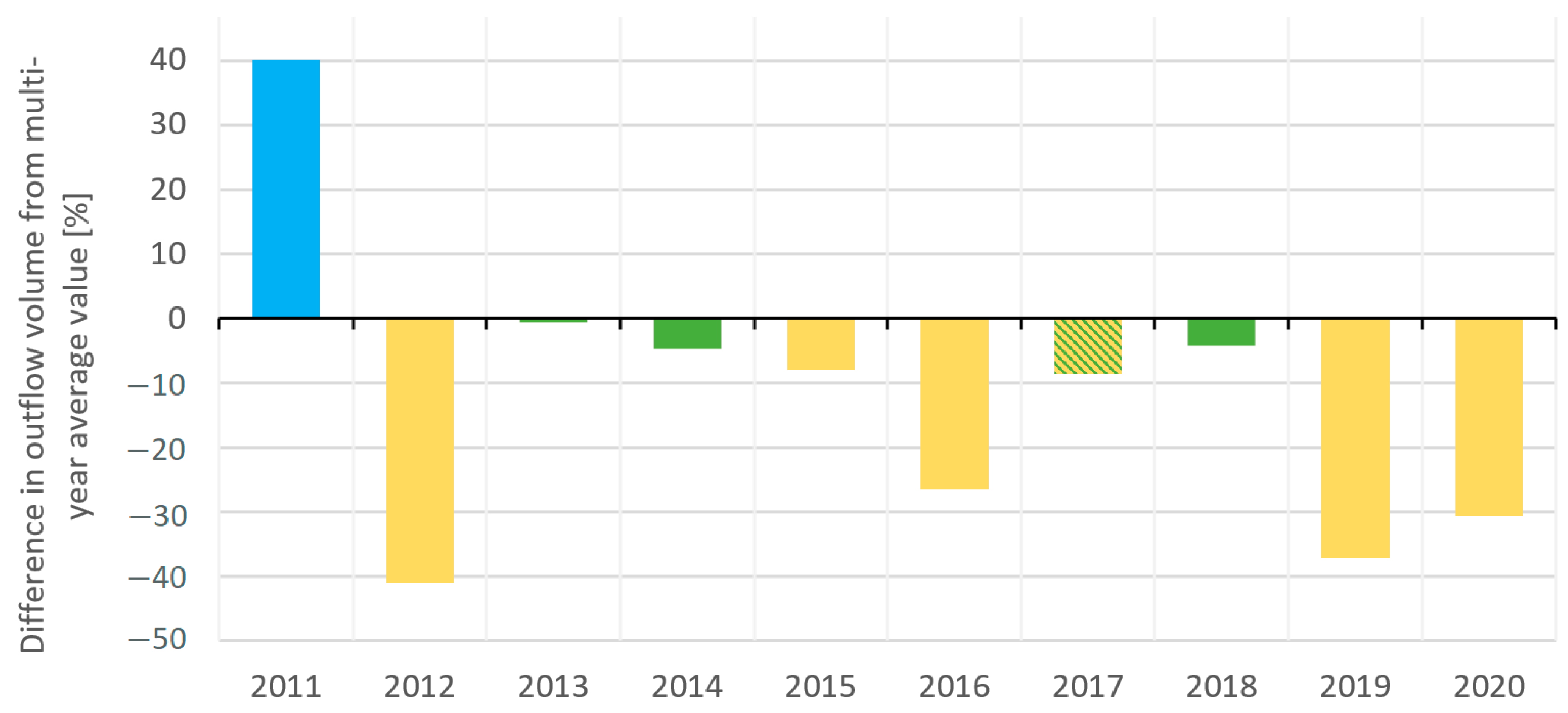

| Selected Parameter | Hydrological Year | |||||||||
|---|---|---|---|---|---|---|---|---|---|---|
| 2011 | 2012 | 2013 | 2014 | 2015 | 2016 | 2017 | 2018 | 2019 | 2020 | |
| Cudnów Piezometer | ||||||||||
| Number of observations | 237 | 1464 | 1460 | 1460 | 1460 | 1464 | 1460 | 1460 | 1460 | 800 |
| SGR [m.below ground] | 0.36 | 0.67 | 0.57 | 0.43 | 0.56 | 0.76 | 0.49 | 0.39 | 0.63 | 0.70 |
| WGR [m. below ground] | 0.20 | 0.22 | 0.03 | 0.04 | 0.26 | 0.43 | 0.04 | 0.02 | 0.11 | 0.40 |
| NGR [m.below ground] | 0.64 | 1.13 | 0.92 | 0.70 | 1.00 | 1.15 | 0.82 | 0.81 | 1.05 | 1.01 |
| Difference between extremes [m] | 0.43 | 0.91 | 0.89 | 0.66 | 0.74 | 0.71 | 0.78 | 0.79 | 0.94 | 0.61 |
| Lipiny Piezometer | ||||||||||
| Number of observations | 244 | 1464 | 1460 | 1460 | 1460 | 1464 | 1205 | no data | 697 | 1464 |
| SGR [m.below ground] | 1.38 | 1.67 | 1.66 | 1.50 | 1.45 | 2.07 | 1.71 | 2.72 | 2.32 | |
| WGR [m. below ground] | 1.04 | 0.94 | 0.62 | 0.88 | 0.59 | 1.10 | 0.75 | 1.72 | 1.39 | |
| NGR [m.below ground] | 1.64 | 2.67 | 2.50 | 2.35 | 2.78 | 3.06 | 2.69 | 3.27 | 3.22 | |
| Difference between extremes [m] | 0.60 | 1.73 | 1.88 | 1.47 | 2.20 | 1.97 | 1.93 | 1.54 | 1.83 | |
| Suskowola Piezometer | ||||||||||
| Number of observations | 250 | 1464 | 1460 | 1460 | 1460 | 1464 | 1193 | no data | ||
| SGR [m.below ground] | 8.67 | 9.18 | 9.45 | 9.33 | 9.12 | 9.48 | 9.54 | |||
| WGR [m. below ground] | 8.46 | 8.63 | 9.07 | 9.00 | 8.97 | 9.34 | 9.33 | |||
| NGR [m.below ground] | 8.95 | 9.69 | 9.82 | 9.51 | 9.36 | 9.66 | 9.68 | |||
| Difference between extremes [m] | 0.49 | 1.06 | 0.75 | 0.51 | 0.39 | 0.32 | 0.35 | |||
| Data [dd.mm.yyyy] | Characteristics of Streamflow Droughts | |||||||||
|---|---|---|---|---|---|---|---|---|---|---|
| Type | Tn | Vn | Qav,n | Qmin,n | Data Qmin,n | Iav,n | ||||
| Days | th.m3 | m3·s−1 | m3·s−1 | dd.mm.yyyy | th.m3 | % | ||||
| 03.06.2011–30.06.2011 | S | 22 | 15.2 | 0.07 | 0.058 | 06.06.2011 | 0.54 | 0.006 | ||
| 18.06.2012–02.10.2012 | S | 85 | 102.8 | 0.06 | 0.043 | 30.06.2012 | 0.96 | 0.011 | ||
| 19.07.2013–16.09.2013 | S | 56 | 154.3 | 0.05 | 0.025 | 31.08.2013 | 2.57 | 0.030 | ||
| 01.07.2015–21.09.2015 | S | 66 | 144.4 | 0.06 | 0.022 | 15.08.2015 | 1.74 | 0.020 | ||
| 07.06.2016–11.07.2016 | S | 24 | 35.9 | 0.07 | 0.048 | 08.06.2016 | 1.03 | 0.012 | ||
| 26.08.2016–24.09.2016 | S | 30 | 50.5 | 0.06 | 0.040 | 29.08.2016 | 1.68 | 0.019 | ||
| 01.06.2017–19.07.2017 | S | 41 | 58.2 | 0.06 | 0.038 | 01.07.2017 | 1.19 | 0.014 | ||
| 31.07.2017–19.08.2017 | S | 20 | 64.3 | 0.04 | 0.021 | 12.08.2017 | 3.21 | 0.037 | ||
| 05.06.2018–23.06.2018 | S | 16 | 20.4 | 0.06 | 0.048 | 20.06.2018 | 1.07 | 0.012 | ||
| 02.06.2019–26.09.2019 | S | 103 | 260.7 | 0.06 | 0.024 | 17.06.2019 | 2.23 | 0.026 | ||
| 16.07.2020–22.08.2020 | S | 37 | 126.7 | 0.04 | 0.016 | 13.08.2020 | 3.42 | 0.040 | ||
| 09.09.2020–26.09.2020 | S | 18 | 37.1 | 0.05 | 0.044 | 18–19.09.2020 | 2.06 | 0.024 | ||
| Period | ∑ni | Tmax,n | data Tmax,n | Tav,n | Qmin,n | data Qmin,n | Vav,n | Vmax,n | Iav,n | |
| / | days | 26.05.1964–21.10.1964 | days | m3·s−1 | dd.mm.yyyy | th.m3 | th.m3 | % | ||
| 1963–2020 | 41 | 141 | 36 | 0.016 | 13.08.2020 | 60.7 | 260.7 | 1.69 | 0.020 | |
| No. | Data [dd.mm.yyyy] | Characteristics of Groundwater Droughts | |||
|---|---|---|---|---|---|
| TG | SGG | NGG | Data NGG | ||
| Days | [m. below Ground] | [m. below Ground] | dd.mm.yyyy | ||
| Cudnów Truncation level = 0.92 m below ground | |||||
| 1 | 04.09.2012–26.10.2012 | 53 | 0.96 | 1.08 | 24.10.2012 |
| 2 | 19.08.2015–24.09.2015 | 37 | 0.96 | 0.99 | 31.08–3.09.2015 |
| 3 | 04.06.2016–29.07.2016 | 56 | 0.94 | 1.03 | 26.07.2016 |
| 4 | 30.08.2016–17.10.2016 | 49 | 1.04 | 1.14 | 30.09–2.10.2016 |
| 5 | 21.07.2019–10.11.2019 | 113 | 0.97 | 1.04 | 11–12.08.2019; 22–25.09.2019; 27–29.09.2019 |
| Lipiny Truncation level = 2.69 m below ground | |||||
| 1 | 27.08.2016–31.10.2016 | 66 | 2.90 | 3.05 | 1–3.10.2016 |
| 2 | 18.07.2019–26.12.2019 | 162 | 3.11 | 3.26 | 1–3.10.2019 |
| 3 | 13.08.2020–30.09.2020 | 49 | 2.72 | 2.95 | 26.09.2020 |
| Suskowola Truncation level = 9.52 m below ground | |||||
| 1 | 20.10.2012–21.05.2013 | 214 | 9.63 | 9.78 | 18.02.2013 |
| 2 | 06.08.2016–09.05.2017 | 277 | 9.61 | 9.68 | 07.12.2016 |
| Streamflow Drought | Difference between Start Date, End Date, and Date When the Lowest Value Is Reached between Hydrological Streamflow Droughts and Hydrogeological Groundwater Droughts (in Days) | |||||||||
|---|---|---|---|---|---|---|---|---|---|---|
| Cudnów | Lipiny | Suskowola | ||||||||
| Data Streamflow Drought [dd.mm.yyyy] | Data Qmin,n | Start | End | NGR | Start | End | NGR | Start | End | NGR |
| 03.06.2011–30.06.2011 | 06.06.2011 | no data | no data | no data | ||||||
| 18.06.2012–02.10.2012 | 30.06.2012 | +78 | +13 | +116 | did not occur | +124 * | +231 * | +233 * | ||
| 19.07.2013–16.09.2013 | 31.08.2013 | did not occur | did not occur | did not occur | ||||||
| 01.07.2015–21.09.2015 | 15.08.2015 | +48 | +3 | +16 | did not occur | did not occur | ||||
| 07.06.2016–11.07.2016 | 08.06.2016 | −3 | +18 | +48 | +81 * | +112 | +115 * | +60 * | +302 | +182 * |
| 26.08.2016–24.09.2016 | 29.08.2016 | +4 | +23 | +33 | +1 | +37 * | +33 | −21 | +227 * | +100 |
| 01.06.2017–19.07.2017 | 01.07.2017 | did not occur | insufficient data | insufficient data | ||||||
| 31.07.2017–19.08.2017 | 12.08.2017 | did not occur | insufficient data | insufficient data | ||||||
| 05.06.2018–23.06.2018 | 20.06.2018 | did not occur | no data | no data | ||||||
| 02.06.2019–26.09.2019 | 17.06.2019 | +49 | +45 | +55 | +46 * | +91 * | +106 * | no data | ||
| 16.07.2020–22.08.2020 | 13.08.2020 | no data | +28 * | +39 | +44 * | no data | ||||
| 09.09.2020–26.09.2020 | 18–19.09.2020 | no data | −27 | +4 * | +8 | no data | ||||
| period | August 2011–May 2020 | August 2011–August 2017 May 2019–October 2020 | August 2011–August 2017 | |||||||
| average of selected * values over the period | +35 | +20 | +54 | +52 | +44 | +88 | +92 | +229 | +208 | |
Disclaimer/Publisher’s Note: The statements, opinions and data contained in all publications are solely those of the individual author(s) and contributor(s) and not of MDPI and/or the editor(s). MDPI and/or the editor(s) disclaim responsibility for any injury to people or property resulting from any ideas, methods, instructions or products referred to in the content. |
© 2024 by the authors. Licensee MDPI, Basel, Switzerland. This article is an open access article distributed under the terms and conditions of the Creative Commons Attribution (CC BY) license (https://creativecommons.org/licenses/by/4.0/).
Share and Cite
Kaznowska, E.; Wasilewicz, M.; Hejduk, L.; Krajewski, A.; Hejduk, A. The Groundwater Resources in the Mazovian Lowland in Central Poland during the Dry Decade of 2011–2020. Water 2024, 16, 201. https://doi.org/10.3390/w16020201
Kaznowska E, Wasilewicz M, Hejduk L, Krajewski A, Hejduk A. The Groundwater Resources in the Mazovian Lowland in Central Poland during the Dry Decade of 2011–2020. Water. 2024; 16(2):201. https://doi.org/10.3390/w16020201
Chicago/Turabian StyleKaznowska, Ewa, Michał Wasilewicz, Leszek Hejduk, Adam Krajewski, and Agnieszka Hejduk. 2024. "The Groundwater Resources in the Mazovian Lowland in Central Poland during the Dry Decade of 2011–2020" Water 16, no. 2: 201. https://doi.org/10.3390/w16020201
APA StyleKaznowska, E., Wasilewicz, M., Hejduk, L., Krajewski, A., & Hejduk, A. (2024). The Groundwater Resources in the Mazovian Lowland in Central Poland during the Dry Decade of 2011–2020. Water, 16(2), 201. https://doi.org/10.3390/w16020201







